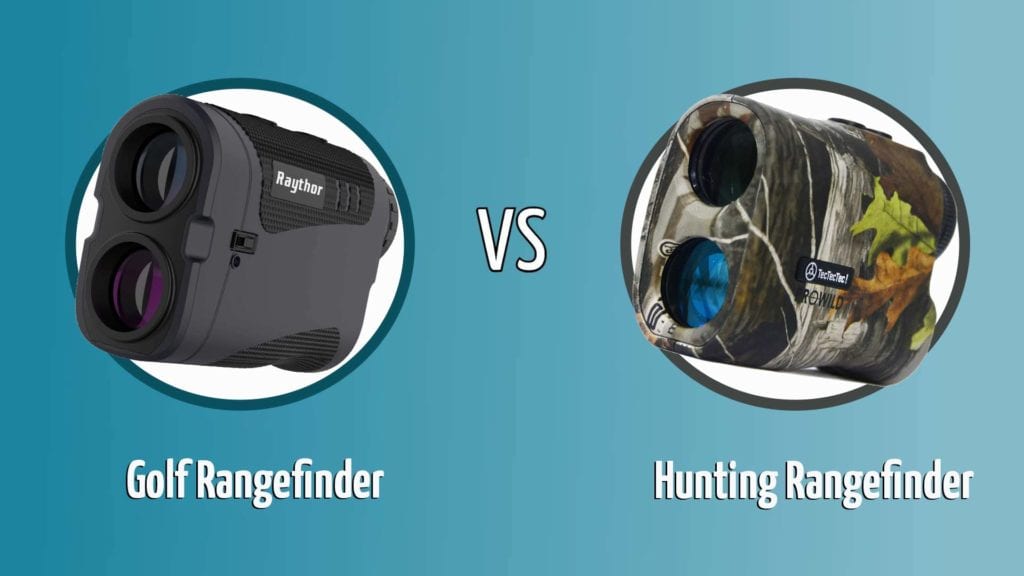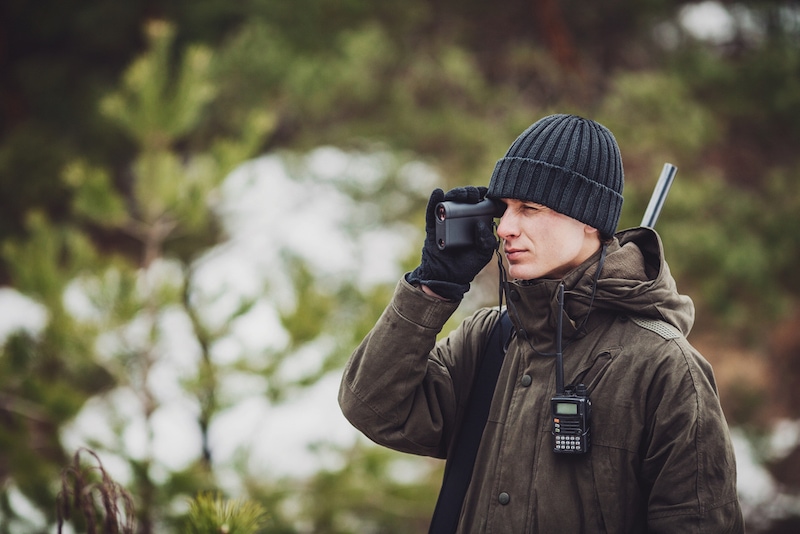Hunting vs Golf Rangefinders: Is There a Real Difference?
Last Updated on

If you look at hunting and golf rangefinders side by side, they seem like pretty similar devices. They’re about the same size, and they’re both laser rangefinders intended to fulfill the same purpose of measuring the distance from where you stand to a specific feature of your choosing.
The one obvious difference is that many rangefinders intended for hunting are covered in camouflage print, but aside from this cosmetic difference, is there any major performance variance between these rangefinders or can any laser rangefinder meet the needs of both golfers and hunters? To find out, we’re going to take a closer look at each of these tools and determine their differences.
Overview of Hunting Rangefinder:

Hunting rangefinders are made to help hunters get an accurate distance to their prey. This allows archers specifically to make their shots since you have to change the arrow’s trajectory for shooting different distances. Rifle hunters might also use a rangefinder, but generally, they’re doing so for much longer distances since a good rifle shooter won’t generally need the extra help within a few hundred yards.
It’s Made Specifically for Hunting
Hunting rangefinders are made specifically with hunting in mind, so there are many features built-in that are hunting-specific. For instance, you can tell most hunting rangefinders instantly by their camouflage print. Not all hunting rangefinders are covered in camo, but many of them are. At the very least, they’re usually neutral colors. You don’t want a brightly colored rangefinder giving you away to your prey in the field.
For hunters, accounting for angle is of vital importance since it will change the trajectory of their shot. Hunting rangefinders include a feature that automatically accounts for slope when ranging, taking a lot of guesswork out of each shot, and improving your odds of making a clean kill.
Hunting isn’t a Daily Occasion
Even for the most avid hunters, hunting isn’t something that’s generally done every day. There are particular seasons when you can hunt certain animals. Depending on the time of year, there may not be many animals that are legal to hunt. So, hunting rangefinders don’t have to deal with daily use for hours at a time. Even during the hunt, the rangefinder will only see a few minutes of use at the most.
Because of this, hunting rangefinders are often made with cheaper parts. They don’t need the greatest battery life to last a long time seeing such occasional use. But they do tend to be very lightweight and compact for easy carrying in the field. Moreover, hunting rangefinders are usually priced pretty reasonably.
- Neutral colors or camo to blend in
- Accounts for slope and angle
- Compact and lightweight
- Not designed for daily use
- Battery life isn’t the greatest
Overview of Golf Rangefinder:

Golf rangefinders look pretty similar to hunting rangefinders but have some different features that are more suited to the game of golf. You certainly won’t see any camo-print rangefinders on the golf course. In fact, you might get laughed off the green for pulling one out! Golf rangefinders are purpose-built to aid you when playing golf.
Built for the Golf Course
Golfers have different needs than hunters, and golf rangefinders are built to reflect that. There are prominent features that most golf rangefinders offer that you just won’t find on a hunting rangefinder. For example, flag lock allows you to lock onto the flag for accurate distances, ensuring that you’re accidentally reading the wrong object.
In many amateur golf tournaments, rangefinders are legal for use. However, there’s a stipulation; you can’t use the slope feature that accounts for hills in your rangefinder. Many golf rangefinders don’t even offer this feature since it’s not legal for tournament play. But other models do offer it; generally, with a way to turn it off so that you can use the rangefinder for tournament play.
Golfing isn’t an Occasional Past-time
Most golfers play golf as much as they possibly can. Many even play daily! And when you play golf, it’s not just for a few minutes. You’ll be playing for many hours, with chances to use your rangefinder on practically every shot. This means that golf rangefinders have to be built for heavy and repeated use.
As such, they’re usually made with high-quality components. They’re also built to be durable in case of accidents, but weatherproofing isn’t as much of a priority. Long battery life is usually a prominent feature of golf rangefinders, so you’re not left dead on the 12th hole with six left to play. This also means that golf rangefinders tend to be pretty pricey.
- Built with features like flag lock and pin lock
- Long battery life
- Built with high-quality components
- The slope feature can be turned off
- Weatherproofing isn’t prioritized
- Many don’t account for slope
- They can be pretty expensive
Hunting vs Golf Rangefinders – The Main Differences
Both types of rangefinders were built to measure the distance between you and another point in the distance. Whether that’s a flag, tree, animal, or something else is only mildly relevant. But each rangefinder is built with some specific intentions, meaning there are going to be differences between them, even if they perform the same job.
Features
One big difference between hunting and golf rangefinders is the type of features they have built-in. Golf rangefinders have golf-specific features like flag lock and pin lock. You won’t find these on a hunting rangefinder. But you will find a camo-print exterior on many hunting models that would never end up on a golf rangefinder.
Priorities
Golf rangefinders prioritize battery life and durability while hunting rangefinders value weatherproofing and portability more. Accuracy tends to be better on golf rangefinders but hunting rangefinders usually have a longer overall range.
Price
Hunting rangefinders aren’t built to withstand the same levels of use as golf rangefinders that might be used for multiple hours on several days each week. As such, hunting rangefinders are often built with cheaper parts, which often makes them the more affordable choice.

Can You Use One Rangefinder for Both?
Even though there are many differences between these tools, at the end of the day, they’re all rangefinders. The main purpose of a rangefinder is to give you accurate readings of distance to specific points or objects and both types of rangefinders are perfectly capable of this.
If you’re going to get a single rangefinder and use it for both hunting and golf, there are some things you’ll want to keep in mind.
First, you don’t want to take a camo-print rangefinder to the golf course. On the other hand, a brightly colored rangefinder of white or some other color will reflect light and can alert prey to your presence. Your best bet is to opt for something neutral colored.
If you plan to play in golf tournaments, then you’ll want to look for a model that either doesn’t have slope correction or allows you to turn the feature off. For hunting, the slope correction is a big plus though, so try to find one that just allows you to shut it off for tournament play.

Since you want to use your rangefinder for golf, look for one with the best battery life possible. It’s also important that you find a model with good weatherproofing, so it doesn’t get ruined on a weekend in the field in some inclement weather.
Conclusion
Is there are a real difference between golf and hunting rangefinders? Absolutely. Golf rangefinders have specific features like flag lock to help with golf. The slope function can also be shut off for tournament play. Hunting rangefinders are smaller for portability and often cheaper. They’re also camo or neutral colors while golf rangefinders are usually brighter. But you can use a single rangefinder for both hunting and golf if you find one that’s accurate, neutral-colored, has good battery life, and allows you to shut off the slope feature for tournament play.
About the Author Dean Eby
An avid outdoorsman, Dean spends much of his time adventuring through the diverse terrain of the southwest United States with his closest companion, his dog, Gohan. He gains experience on a full-time journey of exploration. For Dean, few passions lie closer to his heart than learning. An apt researcher and reader, he loves to investigate interesting topics such as history, economics, relationships, pets, politics, and more.
Related Articles:
What Is the Best Binocular Magnification for Hunting? Optical Features Explained
How to Clean a Refractor Telescope: Step-by-Step Guide
How to Clean a Telescope Eyepiece: Step-by-Step Guide
How to Clean a Rifle Scope: 8 Expert Tips
Monocular vs Telescope: Differences Explained (With Pictures)
What Is a Monocular Used For? 8 Common Functions
How to Clean a Telescope Mirror: 8 Expert Tips
Brightfield vs Phase Contrast Microscopy: The Differences Explained
